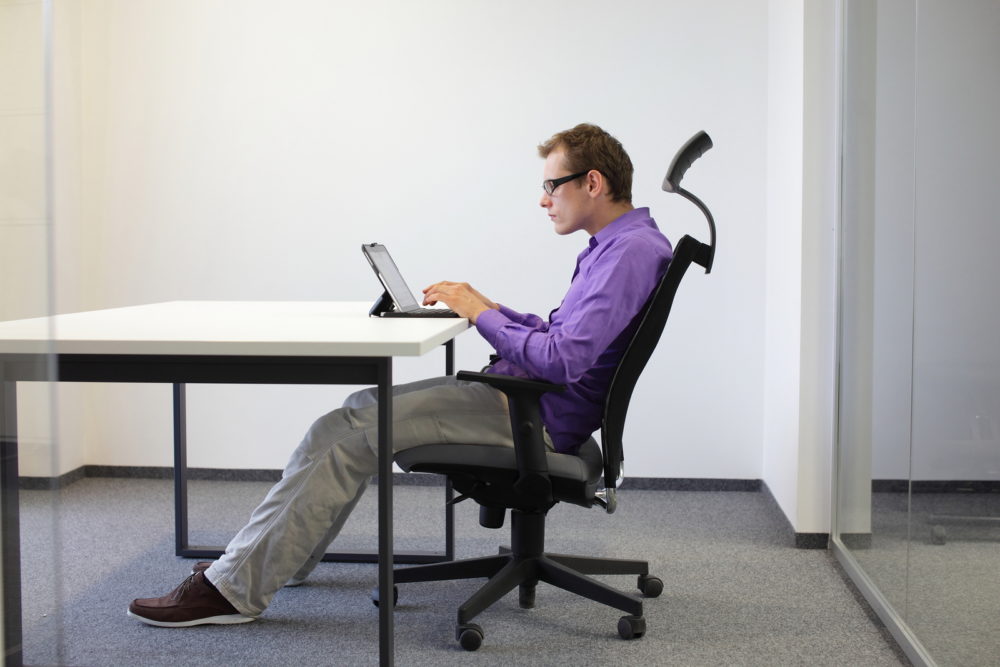We know that they are entering the workforce with pre-existing pain from poor posture and extended daily use of technology; many have pre-existing musculoskeletal disorders.
For the most part, these conditions are left untreated and not diagnosed until they have started their careers. Quite simply, they are experiencing pain, numbness, and discomfort in the neck, upper back, shoulders and wrists.
They know they are not alone. “My hands turn numb and fall asleep while I work on my laptop and use social media, but I keep going because I know my friends are dealing with this too,” shares 15-year-old Kim from New York.
They demand collaborative work environments, and these are created to meet their social and technology needs. But they are far from risk-free and poorly meet their health needs. Providing ergonomic tools and seating is not enough to prevent injury and loss of productivity at work, because the problem is too deeply rooted in their past behavior.
So, what else can we offer them to reduce their pain and keep them gainfully employed? To answer that question properly, we will need to better understand their connection to technology and poor static postures.
What We Know
We have an emerging workforce that is entering the job market with pre-existing medical conditions. Never before has there been a labour group, ready to work, but suffering from musculoskeletal disorders, RSI and other computer-use related ailments. They enter the workforce with a high risk of injury and are in need of medical attention to provide relief.
We have interns and new employees, fresh out of college, who come to us in full-time employment. These new employees are now requesting their 91st day off of work to meet with a medical professional—perhaps a doctor, physical therapist, chiropractor or medical practitioner—in order to seek relief from pain and possible soft tissue injury developed while in school and at home. They are unaware as to why they developed the pain, but they are now seeking relief. They can set an appointment because on the 91st day of employment they have health insurance.
“We have hired engineers straight out of college, and they are requesting a half-day off on their 91st day to see a doctor for what we see as textbook early-neck or other musculoskeletal disorders,” claimed an oil and gas industry executive in March 2016.
A vice-president of healthcare and benefits for a large regional brokerage firm says, “The MSD claim is number one in both frequency and cost for our self-insured clients.”
“The UK’s Health and Safety Laboratory has measured that 50 percent of 11-year-old students are self-reporting back discomfort”
New research by social-influence marketing platform Crowdtap indicates that individuals between 18- and 36-years-old spend an average of 17.8 hours a day with different types of media. These hours represent a total across multiple media sources, some of which are consumed simultaneously.
For example, a 20-something may report spending two hours a day on Facebook, an hour a day answering texts and three hours a day watching television, which would count as six hours total. But this may only take up three hours of her day if she does some of those things at the same time. What if they are now working eight hours a day on a laptop or desktop? We can accurately report that they would then be spending more than nine hours per day using technology.
“Millennials are always on,” says Anna Kassoway, Crowdtap’s chief marketing officer. “Some of it is passive consumption. A lot is media hours that are overlapping.” Generation Y is not just physically tethered to technology, they are emotionally tethered as well. Taking away their technology abruptly or reducing the hours spent on technology produces stress.
Who Was On Watch?
Teachers, parents, family members, all of us. What did we fail to do? We failed to protect our youth. Why? We simply did not know.
Their eyes are being negatively impacted too. Carrie Miranda, a doctor of optometry, explains:
“The reason eyesight problems are becoming more prevalent for the younger folks is because of the demand for clear near vision. Screen sizes can be between five inches and 32” spread across cell phones, tablets, computers and TVs. It takes a lot of visual and muscular energy to move between them…To help prevent this from happening, eye care professionals like to recommend 20/20/20. Every 20 minutes of close work look 20 feet away, or further, for 20 seconds. This will be very helpful to reduce eye strain and prevent distance blur at the end of the day.”
What Can We Do About It?
If left alone, their problems continue and they eventually become injured. They will choose not to work. We know that their technology use impacts their eyesight and their posture; it creates musculoskeletal disorders and affects their overall health. With past employees, we gave them an ergonomic assessment and provided them with recommendations and ergonomic tools.
However, with generation Y traditional furniture is not the norm. Mobile, collaborative, sit-stand and lounge-style seating is more prevalent. They prefer to avoid the systems furniture. Instead of walls they use headphones, peripheral devices and monitors to block out their neighbors, only to remove them for quick and short interactions.
Work hours reflect when work needs to be done, not necessarily during a 9 a.m. to 5 p.m. day. How do you keep an eye on those that do not come to work every day, and those that may require flex hours and are at work when support is not?
What has been provided in the past is not sufficient. They need immediate education, targeted medical attention, and support devices that help reverse the long-term muscle memory. Generation Y and millennials like to research; they respond well to e-learning, but not as well to surveys, unless they believe they will receive a benefit or incentive.
Is it just the millennials that we should be concerned for? We know that students are tethered to their electronic devices for 7.5 hours or more every day in extremely awkward postures. The UK’s Health and Safety Laboratory has measured that 50 percent of 11-year-old students are self-reporting back discomfort. The problem continues to the next generation and may be worse if nothing is done to make a change.
Members of generation Z were born after 1995. Generation Z’ers use five devices:
• A smartphone
• TV
• Laptop
• Desktop
• iPad-style tablets
Members of generation Z are adept researchers. They know how to self-educate and find information. Thirty-three percent watch lessons online, 20 percent read textbooks on tablets and 32 percent work with classmates online.
The average generation Z’er has the attention span of about eight seconds. They have grown up at a time when they’re being served media and messaging from all angles, and they have adapted to quickly sorting through and assessing enormous amounts of information.
In fact, recent studies have found that three quarters of young people believe that they cannot live without the internet, and nearly half of young people claim that they feel happiest when they are online.
So the problem continues, only the tsunami is growing. According to a white paper published by Cardinus Risk Management in October 2015, 79 percent of generation Z consumers display symptoms of emotional distress when kept away from their personal electronic devices. We need smarter solutions, faster.
Bill Pace is president of Cardinus LLC. Bill has worked in the U.S. HR software market since 1995 and has specialized in ergonomics solutions for business for the last 12 years. He has worked with several Fortune 500 and 100 companies, including Honeywell, Travelers Insurance and USAA.





Recent Comments